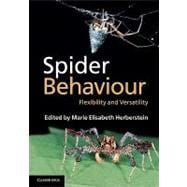
Note: Supplemental materials are not guaranteed with Rental or Used book purchases.
Purchase Benefits
What is included with this book?
| List of contributors | p. viii |
| How this book came about | p. xi |
| spider biology | p. 1 |
| Scope of this book | p. 1 |
| Spider biology | p. 2 |
| The evolutionary history of spiders | p. 17 |
| Conclusion | p. 21 |
| Flexibility in the foraging strategies of spiders | p. 31 |
| Introduction | p. 31 |
| Investments required by extra-oral digestion | p. 33 |
| Silk use, behavioural categories and predatory versatility | p. 35 |
| Flexibility based on chemoreception | p. 36 |
| Flexibility based on vision | p. 38 |
| Searching for sensory-modality trade-offs | p. 40 |
| From aggressive mimicry to mind games | p. 41 |
| Araneophagic salticids | p. 44 |
| Ambushing spiders on tree trunks | p. 46 |
| Plants as spider food | p. 47 |
| Conclusions and outlook | p. 48 |
| Spider webs: evolution, diversity and plasticity | p. 57 |
| Webs, silks and decorations | p. 57 |
| Genetic basis for variation | p. 70 |
| Plasticity in web building | p. 75 |
| Conclusions and outlook | p. 85 |
| Flexible use of anti-predator defences | p. 99 |
| Introduction | p. 99 |
| The predators of spiders | p. 100 |
| Camouflage | p. 101 |
| Masquerade | p. 102 |
| Limb loss as flexible secondary defence | p. 104 |
| Aposematism and Batesian mimicry | p. 105 |
| Practising safe sex in the presence of predators | p. 108 |
| Flexible defence in webs | p. 110 |
| Predator-specific refinement of prey sensory ability | p. 111 |
| Ecotypic variation in predator-identification ability | p. 114 |
| Blurring the distinction between foraging and anti-predator defence | p. 116 |
| Conclusions and outlook | p. 117 |
| Communication | p. 127 |
| Introduction | p. 127 |
| Semiochemicals | p. 129 |
| Acoustic signals | p. 143 |
| Visual signals | p. 156 |
| Multimodal signals | p. 162 |
| Social interactions | p. 164 |
| Conclusion and outlook | p. 165 |
| Deceptive signals in spiders | p. 190 |
| The evolution of deceptive signals | p. 190 |
| Deception via colour | p. 191 |
| Deception via scent | p. 199 |
| Deception via vibrations | p. 202 |
| Conclusions and outlook | p. 207 |
| Mating behaviour and sexual selection | p. 215 |
| Introduction | p. 215 |
| Mate attraction and approach | p. 216 |
| Mating | p. 233 |
| Consequences of polyandry | p. 241 |
| Conclusions and outlook | p. 255 |
| Group Iiving in spiders: cooperative Dreeding and coloniality | p. 275 |
| Introducing group-living spiders | p. 276 |
| Subsocial spiders, and the subsocial route to cooperative sociality | p. 278 |
| Cooperative social spiders | p. 279 |
| Conclusions and outlook - social spiders | p. 288 |
| Colonial spiders | p. 290 |
| Conclusions and outlook - colonial spiders | p. 298 |
| Plasticity, learning and cognition | p. 307 |
| Overview | p. 307 |
| Predation | p. 308 |
| Interactions with other animals | p. 319 |
| Spatial learning and navigation | p. 323 |
| Heat aversion | p. 329 |
| Environmental enrichment | p. 330 |
| The Deurobiological basis of learning | p. 330 |
| Conclusions and outlook | p. 333 |
| Kleptoparasitic spiders of the subfamily Argyrodinae: a special case of behavioural plasticity | p. 348 |
| Introduction | p. 348 |
| Phytogeny and the flexibility of Argyrodinae foraging behaviours | p. 350 |
| Argyrodinae and webs | p. 361 |
| Flexibility of kleptoparasitic behaviours | p. 363 |
| Flexibility of araneophagic behaviours | p. 369 |
| Sociality and foraging behaviours | p. 371 |
| Competition for mates and mating behaviour | p. 374 |
| Conclusions and outlook | p. 379 |
| Index | p. 387 |
| Table of Contents provided by Ingram. All Rights Reserved. |
The New copy of this book will include any supplemental materials advertised. Please check the title of the book to determine if it should include any access cards, study guides, lab manuals, CDs, etc.
The Used, Rental and eBook copies of this book are not guaranteed to include any supplemental materials. Typically, only the book itself is included. This is true even if the title states it includes any access cards, study guides, lab manuals, CDs, etc.